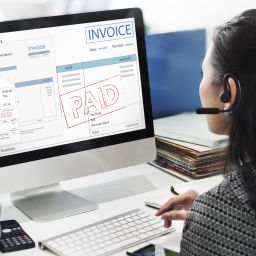
In the digital age, electronic invoicing has become a cornerstone of modern business transactions in the United Arab Emirates (UAE). As the nation strengthens its digital infrastructure, e-invoicing systems are helping companies simplify tax compliance, streamline invoicing processes, and reduce manual data entry errors. With Dubai emerging as a regional hub for innovation, e-invoicing solutions are reshaping how businesses handle invoices, payments, and data processing.
Understanding E-Invoicing in the UAE
E-invoicing, or electronic invoicing, is the digital exchange of invoice data between suppliers and buyers using a structured electronic format instead of traditional paper invoices or PDF invoices. Unlike manual systems, e-invoices are generated, transmitted, and received electronically through ERP systems or cloud-based invoicing platforms.
The UAE’s Federal Tax Authority (FTA) encourages digital invoicing to improve VAT compliance, minimize fraud, and enhance transaction visibility. By adopting e-invoicing regulations, the government aligns with international standards such as PEPPOL and Universal Business Language (UBL) formats, ensuring structured data exchange between trading partners.
FTA and Regulatory Requirements
The FTA’s e-invoicing requirements are part of the country’s broader digital transformation strategy. Businesses must ensure invoices meet regulatory requirements, including correct VAT data, supplier and buyer details, and unique invoice identifiers.
In compliance with tax authorities, each electronic invoice must be stored digitally, ensuring data security and audit-ready reporting. This aligns with the FTA’s goal of promoting continuous transaction controls (CTC), allowing real-time or near-real-time monitoring of business transactions.
Benefits of E-Invoicing for Businesses in Dubai
Dubai’s thriving B2B environment relies heavily on efficiency and automation. E-invoicing software offers several benefits for businesses of all sizes:
1. Tax Compliance and Accuracy
E-invoicing reduces human errors common in manual data entry or traditional invoicing. Automated systems ensure that every invoice follows FTA regulations, including proper VAT calculations, tax codes, and transaction timestamps.
2. Faster Payments and Better Cash Flow
Through digital invoices and automated payment integration, companies experience quicker payment cycles. Businesses can track payments and reconcile accounts in real-time, improving cash flow and financial visibility.
3. Cost Savings and Efficiency
Replacing paper invoices with electronic invoices saves costs related to printing, mailing, and manual processing. Automation streamlines the accounts payable and accounts receivable workflows, reducing administrative overhead.
4. Enhanced Transparency and Fraud Prevention
The structured invoice data format, along with AI-powered verification systems, minimizes risks of duplicate or fraudulent invoices. The use of digital signatures and secure data transmission ensures authenticity and traceability across all transactions.
5. Integration and Scalability
Modern e-invoicing solutions integrate easily with ERP systems, accounting software, and cloud platforms, enabling businesses to manage invoicing at scale. Whether through OpenText, FreshBooks, or custom cloud-based platforms, companies can expand without changing their financial infrastructure.
How E-Invoicing Systems Work
An e-invoicing system operates through a sequence of digital processes designed for efficiency and accuracy:
- Invoice Creation – The supplier creates an invoice using an ERP system or e-invoicing platform, capturing essential tax and transaction data.
- Validation – The system validates the invoice format, ensuring compliance with FTA’s electronic invoicing mandates and standardized schema.
- Transmission – The electronic invoice is securely transmitted to the buyer via a cloud infrastructure or EDI (Electronic Data Interchange).
- Payment and Reconciliation – Once approved, payments are processed through automated payment gateways or FreshBooks Payments, ensuring accuracy and timely settlements.
- Archiving and Reporting – Finally, the invoice data is stored in a digital archive for audit and regulatory reporting, ensuring long-term compliance.
This automated workflow eliminates manual steps and paper dependencies, enabling a smooth, end-to-end invoicing process.
Key Features of E-Invoicing Software in UAE
Modern e-invoicing software in Dubai and across the UAE comes equipped with advanced functionalities that align with business and regulatory needs:
- Structured XML/UBL format for data standardization
- AI-based data extraction to automate invoice verification
- Integration with ERP systems and accounts payable departments
- Cloud-based management and public cloud scalability
- Real-time reporting and tax audit trail visibility
- Automated error detection and invoice validation
- Secure storage for digital and PDF invoices
These features support supply chain management, billing, and accounting processes, making e-invoicing an essential part of modern business management systems.
E-Invoicing vs. Traditional Invoicing
Traditional invoicing relied on paper-based or PDF invoices, often processed manually. This method is prone to delays, errors, and data duplication. In contrast, electronic invoicing provides a standardized format where each transaction is processed digitally, ensuring accuracy, speed, and compliance.
| Aspect | Traditional Invoicing | Electronic Invoicing |
|---|---|---|
| Format | Paper/PDF | Structured XML/UBL |
| Process | Manual | Automated |
| Errors | High risk | AI error detection |
| Compliance | Manual checks | FTA-aligned automation |
| Cost | High printing/shipping | Low digital cost |
| Speed | Slow | Instant transmission |
| Reporting | Manual records | Real-time dashboards |
This transformation illustrates how e-invoicing implementation not only supports compliance but also promotes digital transformation across industries in the UAE.
E-Invoicing Implementation in the UAE
Implementing e-invoicing solutions in Dubai requires a structured approach:
- Assessment and Planning – Businesses should evaluate current invoicing processes, identify gaps, and define integration needs with existing ERP systems.
- Choosing the Right Software – Select an FTA-compliant e-invoicing software that supports structured formats, AI automation, and secure data storage.
- System Integration – Seamless integration with accounts payable automation, purchase orders, and billing systems ensures smooth adoption.
- Training and Change Management – Staff should be trained on the new e-invoicing system, focusing on process efficiency and tax compliance.
- Testing and Go-Live – Run pilot tests to validate invoice data, formats, and payment workflows before going fully digital.
Proper implementation ensures that businesses comply with FTA tax mandates while gaining operational efficiency.
Global Standards and Influence
While the UAE builds its own e-invoicing framework, it draws insights from global systems such as those used in the European Union (EU) and United States (U.S.). The European Commission’s e-invoicing regulations emphasize standardized formats and structured data using XML and UBL schemas.
Similarly, the concept of VAT in the digital age has influenced UAE’s adoption of e-invoicing compliance systems that integrate tax reporting with digital transaction monitoring.
By aligning with global standards, UAE businesses enhance international trade, transparency, and tax efficiency across borders.
AI, Automation, and the Future of Invoicing
The future of invoicing in Dubai lies in AI-driven automation and cloud-based platforms. With technologies such as machine learning and electronic data interchange (EDI), accounts payable departments can automatically extract and process invoice data.
AI automation minimizes fraud, ensures accuracy, and optimizes payment timing, offering greater control over business transactions. Companies like OpenText, FreshBooks, and other leading providers are investing heavily in AI-enhanced invoicing solutions to support B2B efficiency and compliance.
As digital transformation accelerates, e-invoicing work will become central to every business process, driving efficiency, cost savings, and visibility across the supply chain.
Conclusion
The rise of e-invoicing in the UAE marks a major step toward a fully digital economy. Through automation, AI, and cloud-based platforms, businesses in Dubai can ensure FTA tax compliance, enhance accuracy, and simplify financial operations.
By adopting modern e-invoicing systems, companies unlock the benefits of real-time reporting, reduced errors, faster payments, and long-term cost efficiency. As the UAE continues its journey toward digital transformation, electronic invoicing will remain a vital part of its business and tax ecosystem — promoting innovation, compliance, and trust in every transaction.










